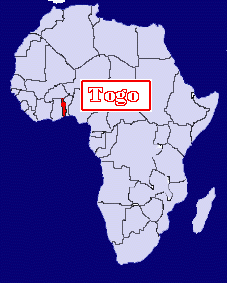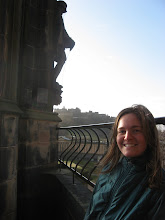Hey everyone! I hope you are doing well. Things in Togo are going well also.
Rainy season has begun, and so everyone in village has been busy cultivating; preparing fields, and the first things in the ground are corn, peanuts and tomatoes.,Yams that were planted in March have germinated as well. It is the men who go to the fields and cultivate, ready the ground for planting, and then it is the women who plants things like corn and peanuts. There are a few tools that people use, mainly the hoe, (there is a larger and smaller version) a larger hoe called the daba, and a machete. For cultivating, men use the daba, a oval shaped shovel that is attatched to a short handle, maybe 2 and a half feet long, fixed at a 45 degree angle. The hoe is like this also, but a smaller shovel. Thus, all work is done bent over at the waist. Young children are expected to cultivate as well, you will see them marching off to the fields saturday morning with their father. It's hard work, but the fields look great when they are finished.
As I said, women go to plant corn and peanuts. As everything is done by hand, their technique for planting accurately and efficiently is amazing, and I learned a lot when I went with two of my host sisters to plant. You fill a small bowl with corn, and hold this in your left hand. In your right hand, you have a small hoe, or a stick, or a machete. You make a hole with the stick, and using only your left hand pick up two kernels of corn, throw it in the hole, then cover the hole again. This is done is three fast movements, make a hole, drop corn, cover. Make a hole, drop corn, cover. Over and over and over. The tricky part is holding the bowl of corn and picking up corn kernels at the same time. It takes some practice, but once you get the hang of it, it is really fun, and with two or three people you can really get a lot planted.
Aside from planting with my host family, I was given a small parcel of land to cultivate and do experiments with compost, different vegetables, and a nitrogen fixing cover crop called Mucuna. I've been cultivating it myself, and it feels really great to do that kind of work. I remember preparing beds at JenEhr, the farm in Wisonsin where I used to work, and it just brings me back. Here, I do all the bed preping with a small hoe. My family and neighbors have all been helping me also, giving me advice on how to best cultivate, make yam mounds and use the hoe. I feel like making this garden is really important for a couple reasons. One, I can plant different things that people normally don't plant, but will be beneficial for improving soil quality, or beneficial for their health, planting more vegetables. Also, I want people to see that I can make a garden. A lot of times if I try to do something that people here do daily, like cultivating, the response is 'oh, no, you can't.' At times this can be frustrating and make you feel bad. The whole 'I can't not being part of your vocabulary' idea I feel I grew up with in the states. So, I say, let me try. And they do. Afterall, I am here to learn too, and the only way I'll do that is by trying lots of different things.
Tuesday, May 18, 2010
Subscribe to:
Post Comments (Atom)



2 comments:
You are amazing! I love reading about your life there. Hope your garden is a success!
Great post, thanks for keeping us updated. You're wonderful Katie! What are you planting? What do you think about when you work on your garden? Love, Gabby
Post a Comment